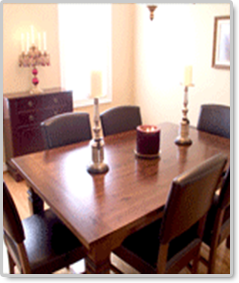Caring For Your Fine Wood Furniture

First, fine wood furniture hates extremes of temperature and humidity. As such, you should keep your home from becoming too dry or too humid, and too hot or too cold. In particular, being too dry can lead to cracking and warping of your furniture. Also, you should not allow your fine wood furniture to be exposed to direct sunlight, as this can cause damage by raising the temperature of the wood and finish, and direct sunlight can also cause permanent color changes of the wood (helpful accessories: indoor humidity monitors; wood polishers and conditioners).
The type of finish on the wood, not the type of wood itself, determines how fine wood furniture should be cared for and cleaned. Finishes may be soft (such as Tung oil or Danish oil finishes) or hard (lacquer or polyurethane finishes), or it can be a painted finish. You should clean and condition the surfaces of your fine wood furniture in accordance with the manufacturer's recommendation for the finish on your particular furniture.
Never use wax or furniture polish on fine wood furniture that has an oil finish, instead re-oil yearly with boiled linseed oil, Tung oil, or a product recommended by the manufacturer. Too much polish can build-up a cloudy film. So do not polish more than 3-4 times a year, unless your furniture gets very heavy use. And do not mix types of polish. Oil, for example, causes wax to become gummy. And be sure to clean the furniture surface thoroughly before changing furniture care products.
You should vacuum your fine wood furniture regularly with a dusting brush attachment to gently remove dust from furniture surfaces. Or you can gently use a clean soft cloth or soft paper towel, turning it often, to pick up dust (helpful accessories: dusting cloths; linen and cotton table mats). You should dust your furniture before vacuuming the floor around it, especially if you do not have a central vacuum system which will remove the dust from room.
To protect your furniture from scratches, spills and heated objects, you should be sure to place pads, mats and coasters on your furniture, and place mats under vases, glasses, cups etc. However, rubber or plastic mats should NOT be used unless specifically marked as being safe for wood, since some of these items may soften or stain the finish. Be sure to use felt under any objects that could scratch the fine wood. And if you do any any spills, you should immediately wipe them up to prevent spots that could require refinishing.
Related Articles . . .
Getting Rid of Winter Dryness
During the wintertime, the relative humidity in your home can drop below 15% causing a variety of health, comfort and woodwork problems for your home. This article gives helpful ideas for increasing the humidity in your home.
Creative Ways for Increasing Home Humidity
Dry air in your home during the winter can cause problems affecting your family's health and comfort, and can damage your home's expensive woodwork. This article gives you some creative options for increasing the humidity in your home.
Reducing Humidity in Your Home: Why & How-To
As we head towards the hot summer months, home humidity becomes a problem. This article discusses: the benefits of reducing home humidity; signs that your humidity is too high; and steps you can take to reduce humidity in your home.
Making Your Leather Furniture Last
Leather furniture is a gorgeous addition to your home, and with the proper care, it can last a lifetime. This article describes how to protect your leather furniture; how to properly clean it; and when repairs are needed.
Caring For Upholstered Furniture
Whether your upholstered furniture is brand new or 100 years old, here are some tips for how to protect it, maintain it, and how to handle routine spills.









